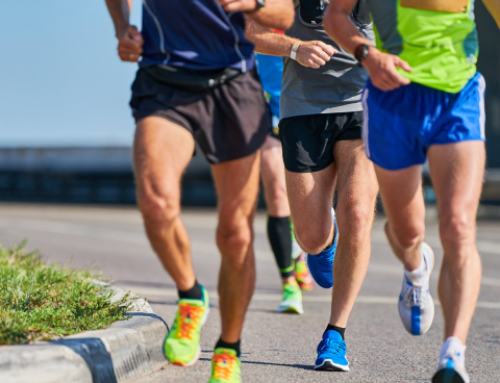Maximize Your Trail Running
Trail running is essential when training for an obstacle race or mud run, many of which include some type of trail. Navigating a trail requires coordination, balance and agility. Running by itself will not be enough to get you ready.
One way to train for the trail is to add intervals to your trail run, stopping every quarter to half mile to do a full bodyweight circuit. Intervals are very effective in raising your heart rate and increasing your muscular endurance.
Another great way to spice up your trail runs is to add short sprint intervals followed by two bodyweight exercises. The sprint intervals are similar to the Hurricanes in the Training for Warriors System. Sprint intervals raise your heart rate and force you to perform strength exercises as you would during any type of obstacle race.
Sprinting during your training is important because it allows you to increase both your anaerobic and aerobic capacity during recovery. The increase in work capacity will transfer to racing. It will also help you become more explosive and stay lean by burning fat, which works to your advantage on race day because extra body weight can slow you down.
Sprinting also builds mental toughness, which is essential for some of the more popular obstacle races.
Here’s how we perform our trail-running sprints in the Obstacle Course Training System:
Start with a 10-minute run. Your heart rate should be pretty steady. This is the point where you begin to sprint. Sprint through the trail for 15 seconds. You will be moving fast, so you need to keep yourself sharp and look where you are placing your feet on every step. Once you complete the 15-second sprint, you will perform two bodyweight exercises then continue running.
Here is a sample trail running with sprints training session:
- Run 10 minutes.
- Set 1: Sprint 20 seconds, followed by 25-yard Bear Crawl and 25 Bodyweight squats.
- Run 2 minutes.
- Set 2: Sprint 20 seconds, followed by 25-yard Bear Crawl and 25 Bodyweight squats.
- Run 2 minutes.
- Set 3: Sprint 20 seconds, followed by 25-yard Bear Crawl and 25 Bodyweight squats.
- Run 5 minutes.
- Set 4: Sprint 20 seconds, followed by 25-yard Tiger Crawls (Spiderman Crawls) and 25 Walking Lunges.
- Run 2 minutes.
- Set 5: Sprint 20 seconds, followed by 25-yard Tiger Crawls (Spiderman Crawls) and 25 Walking Lunges.
- Run 2 minutes.
- Set 6: Sprint 20 seconds followed by 25 yard Tiger Crawls (Spiderman Crawls) and 25 Walking Lunges.
- Run 5 minutes.
- Set 7: Sprint 20 seconds, followed by 20 Push-Ups and 24 Split-Jumps.
- Run 2 minutes.
- Set 8: Sprint 20 seconds, followed by 20 Push-Ups and 24 Split-Jumps.
- Run 2 minutes.
- Set 9: Sprint 20 seconds, followed by 20 Push-Ups and 24 Split-Jumps.
- Run 2 minutes.
The exercise selection after the sprint is geared toward enhancing both upper-body and lower-body muscular endurance. This type of trail running training session will test many different fitness qualities required for any obstacle race or mud run.
Add these into your weekly training, and on race day, you will come out on top.
Read more:
- Reebok ATV19+ Real Athlete Performance Review
- adidas ClimaCool Ride Trail Running Shoe
- Training for Mud Runs, Part 4: Long Trail Runs
RECOMMENDED FOR YOU
MOST POPULAR
Maximize Your Trail Running
Trail running is essential when training for an obstacle race or mud run, many of which include some type of trail. Navigating a trail requires coordination, balance and agility. Running by itself will not be enough to get you ready.
One way to train for the trail is to add intervals to your trail run, stopping every quarter to half mile to do a full bodyweight circuit. Intervals are very effective in raising your heart rate and increasing your muscular endurance.
Another great way to spice up your trail runs is to add short sprint intervals followed by two bodyweight exercises. The sprint intervals are similar to the Hurricanes in the Training for Warriors System. Sprint intervals raise your heart rate and force you to perform strength exercises as you would during any type of obstacle race.
Sprinting during your training is important because it allows you to increase both your anaerobic and aerobic capacity during recovery. The increase in work capacity will transfer to racing. It will also help you become more explosive and stay lean by burning fat, which works to your advantage on race day because extra body weight can slow you down.
Sprinting also builds mental toughness, which is essential for some of the more popular obstacle races.
Here’s how we perform our trail-running sprints in the Obstacle Course Training System:
Start with a 10-minute run. Your heart rate should be pretty steady. This is the point where you begin to sprint. Sprint through the trail for 15 seconds. You will be moving fast, so you need to keep yourself sharp and look where you are placing your feet on every step. Once you complete the 15-second sprint, you will perform two bodyweight exercises then continue running.
Here is a sample trail running with sprints training session:
- Run 10 minutes.
- Set 1: Sprint 20 seconds, followed by 25-yard Bear Crawl and 25 Bodyweight squats.
- Run 2 minutes.
- Set 2: Sprint 20 seconds, followed by 25-yard Bear Crawl and 25 Bodyweight squats.
- Run 2 minutes.
- Set 3: Sprint 20 seconds, followed by 25-yard Bear Crawl and 25 Bodyweight squats.
- Run 5 minutes.
- Set 4: Sprint 20 seconds, followed by 25-yard Tiger Crawls (Spiderman Crawls) and 25 Walking Lunges.
- Run 2 minutes.
- Set 5: Sprint 20 seconds, followed by 25-yard Tiger Crawls (Spiderman Crawls) and 25 Walking Lunges.
- Run 2 minutes.
- Set 6: Sprint 20 seconds followed by 25 yard Tiger Crawls (Spiderman Crawls) and 25 Walking Lunges.
- Run 5 minutes.
- Set 7: Sprint 20 seconds, followed by 20 Push-Ups and 24 Split-Jumps.
- Run 2 minutes.
- Set 8: Sprint 20 seconds, followed by 20 Push-Ups and 24 Split-Jumps.
- Run 2 minutes.
- Set 9: Sprint 20 seconds, followed by 20 Push-Ups and 24 Split-Jumps.
- Run 2 minutes.
The exercise selection after the sprint is geared toward enhancing both upper-body and lower-body muscular endurance. This type of trail running training session will test many different fitness qualities required for any obstacle race or mud run.
Add these into your weekly training, and on race day, you will come out on top.
Read more:
- Reebok ATV19+ Real Athlete Performance Review
- adidas ClimaCool Ride Trail Running Shoe
- Training for Mud Runs, Part 4: Long Trail Runs











